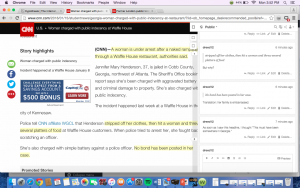“The nonverbal is typically poised as an extension of hearing culture rather than a fundamental expression of an embodied human experience, capable of infinite articulation” (Hunter).
In Plato’s Phaedrus, the audience is entertained with colorful dialogue between Socrates and Phaedrus. Phaedrus reads Lysias’ speech on the downfalls of men in love, which prompts the two men to enter into dialogue regarding the soundness of the speech. Socrates then recreates Lysias’ speech, but after speaking, he feels compelled to recant his argument and make a case for love. His argument features the famous horse-drawn chariot metaphor: he uses two horses, one pure and one irrational and carnal, to illustrate the battle between good and evil that rages within man. After his speech, he and Phaedrus begin to converse on rhetoric, writing, and speech. Socrates argues that rhetors must be armed with as much knowledge as possible: especially knowledge of the audience and the subject matter at hand. Socrates also uses the myth of Theuth to argue against the value of writing, in which he states that words cannot adapt to audiences like oratory can.
Leeann Hunter’s essay, “The Embodied Classroom: Deaf Gain in Multimodal Composition and Digital Studies,” describes her experiences as a Child of Deaf Adults and how those experiences shaped the way she teaches her students–specifically how she has learned to use the physical space of her classroom as a part of nonverbal communication. Her background forced her to reevaluate how she viewed nonverbal communication and the use of classroom space. She emphasizes the importance of visual rhetoric and how expanding beyond the typical classroom lecture allowed her to truly engage her students. Hunter also spoke on the importance of embodiment in the digital classroom, where she used modernist literature to put data in conversation with the “complexity of the human experience” (Hunter). In conclusion, she argues that the hearing community has much to gain from pedagogical practices in what she calls “Deaf Gain.”
How do these pieces interact?
Phaedrus and “The Embodied Classroom” both illustrate the importance of audience awareness. During his discussion with Phaedrus, Socrates says, “. . . he who would be an orator has to learn the differences of human souls–they are so many and of such a nature, and from them come the differences between man and man” (Phaedrus). With this quote, he affirms that audience knowledge is fundamental to the use of rhetoric–without it, persuasion cannot be practiced. Hunter speaks on audience knowledge in a unique way: she describes the benefits of bringing non-hearing pedagogical practices into the hearing classroom. She reflects on the “transformation” in her classroom after practicing nonverbal skits with her students: instead of looking at their laptops or phones during class, they focus on her and her lesson. She says that the classroom is “no longer a single place, but rather an interface. . .” (Hunter). Hunter’s skit was a multimodal performance that used spatial and visual modes to engage her audience. She was aware of her audience, which allowed her to find a new way to shift her students’ attention to her and away from their technology.
The Importance of Nonverbal Communication
While Plato and Hunter both speak on the importance of audience awareness, Plato fails to account for nonverbal communication and visual rhetoric. When discussing rhetoric, we must take all aspects of communication into consideration, including body language. Rhetoric doesn’t stop at language; rather, language is used as an arbitrary symbol for something human and concrete.
“When we transform our pedagogical practices in the face-to-face classroom to value the deep learning that comes with human interaction and embodiment. . . our students gain ethical knowledge that values human difference” (Hunter).
Although this video shows a prank, it illustrates the power of nonverbal communication and the divide between verbal and nonverbal communication. Source: “World’s Wildest Meme Prank.” YouTube.
Although Plato seems to forget the power of body language, his stress on the importance of audience awareness and knowing as much as possible can be transferred into the modern classroom. When Hunter changed her teaching style, she engaged her students. Her previous teaching methods had been effective, but she observed that her students had a tendency to lean on technology for entertainment. Her students began to engage with her because she changed her teaching methods based on her knowledge of her audience: she realized that the responsibility to be active in the classroom did not belong only to her students.
The Written Word vs. Visual Rhetoric
In Phaedrus, Plato also talks about his personal qualms with writing: how effective can writing be if the writer is not present to make sure his or her message is being received? How can a piece of writing adapt to its audience?
Plato seems to be forgetting the diversity of human communication. Writing allows us to read words from the past, and when we write, we take a risk knowing that our work may be interpreted differently than we interpreted ourselves. The problem with writing is that it does not reach a universal audience. For someone that has only communicated in body language, words hold less meaning. But, for someone that has only known words, the images that the written word can produce may not have their full effect. Plato favors oratory, but even the best speech would not reach a non-hearing audience (or any audience that speaks a different language) without an interpreter. Hunter addresses this problem with her emphasis on the visual, where she proposes that instead of focusing on what is “correct” in standard English, educators and students need to focus on the physical aspect of communication and how it can translate into writing.

Even without the text “Smoking kills,” the audience would most likely understand the advertisement because of the visual illustration. Source: “Attraction and Persuasion in Advertising: A beginner’s guide to visual rhetoric”
Conclusion
As Plato argued, the use of rhetoric must be approached with as much audience knowledge as possible. But, as our world evolves, so must rhetoric. Hunter’s emphasis on visual rhetoric does not reduce the credibility of the written or spoken word; rather, it adds to the power that rhetoric holds.
Sources:
Hunter, Leeann. “The Embodied Classroom: Deaf Gain in Multimodal Composition and Digital Studies.” The Journal of Interactive Technology and Pedagogy. CUNY Academic Commons, 17 Dec. 15. Web. 24 Jan. 2016.
It’s Going To Be A Wild Ride. “World’s Wildest Mime Prank.” YouTube. YouTube, 4 September 2009. Web. 26 January 2016.
Ly-Le, Tuong-Ming. “Attraction and Persuasion in Advertising: A Beginner’s Guide to Visual Rhetoric.” LinkedIn. 9 Aug. 2014. Web. 28 Feb. 2016.
Phaedrus by Plato. Trans. Benjamin Jowett. The Internet Classics Archive, 2009. Web. 24 Jan. 2016.
